I found a website that suggested that John Travolta had a hair system. Can you explain how this works for me? The site is Faded Youth
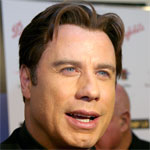 Some of the finer hair systems are created with a fine mesh material which then has hairs attached to the mesh, put together a hair at a time. At the hairline, a transparent plastic type material is used to match the skin tones and it is attached (glued) to the skin. For the mesh part behind the leading hairline edge, the hairs are layered so that the fine mesh does not show. The transition from front to back of the system must be meticulously put together.
Some of the finer hair systems are created with a fine mesh material which then has hairs attached to the mesh, put together a hair at a time. At the hairline, a transparent plastic type material is used to match the skin tones and it is attached (glued) to the skin. For the mesh part behind the leading hairline edge, the hairs are layered so that the fine mesh does not show. The transition from front to back of the system must be meticulously put together.
Please note that I am taking the photos on the site you referenced at face value, and believe they are actual photos of John Travolta and not Photoshopped images. If these photos are his, unfortunately for John Travolta, an aggressive photographer caught this view of what appears to be a hair system. From any reasonable distance, a good hair system looks like a normal head of hair and I complement the folks that made this system. Such hair systems are very expensive and take considerable maintenance to keep them attached to the scalp and to keep them clean and odor free. Maintenance means that the person wearing them comes into a special facility (some get the experts to go to their home) to get them washed, repositioned and/or reattached as the hair under the system grows and the skin turns over from normal growth. The frequency of this maintenance process may be 3-4 times per month, on average. Monthly maintenance costs for good systems run upward of $250/month and the more affluent clients may pay substantially more for the better systems. The scalp below the mesh often grows some hair and the skin itself sheds as a normal part of the body’s replacement function. The scalp skin turnover rate runs about 14 days, which means that all of the skin of the scalp sheds and is replaced with new skin a couple of times per month. The old skin obviously has no where to go, so it accumulates under the mesh in flakes and eventually decays, developing a characteristic ‘musty’ odor associated with skin that is not washed away regularly. Even if the person can wash with the hair system in place, dead flakes of skin still build up and with added moisture, it becomes a culture broth for bacteria. When these systems are changed often and washed frequently, the person wearing them must have spare hair systems to wear. The good ones cost many thousands of dollars. Add to that the cost of weekly maintenance, and most people would be surprised to find that the cost of a hair transplant may be reached within a year or two in the hair system costs. Even for the normal run-in-the-mill hair systems, total costs (one or two hair systems plus maintenance) may exceed $3,000/year. In these photographs of Mr. Travolta, the edges of the hair system are marked with arrows and the mesh is circled in red, in case you can not see it. I’ve also lightened the photo so that you can see the problem a little clearer, though if you look at the source photos, you should be able to see the issues on their own. Click the photos below to enlarge.
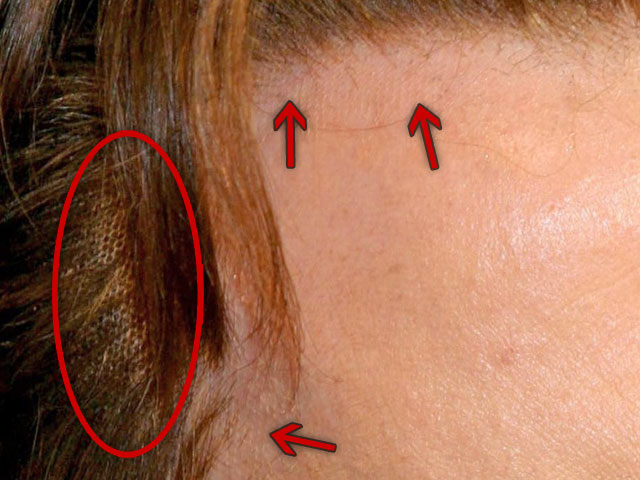
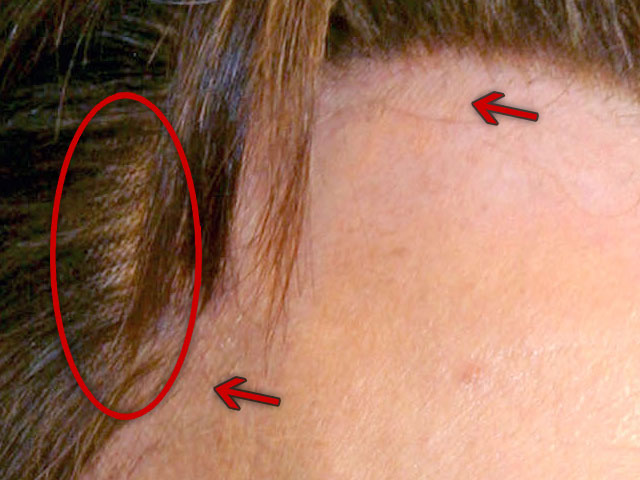
The source photos are here and here.
These mesh systems produce traction alopecia, which means that they produce hair loss from the constant pull of the glues used to keep them attached to the skin that stop them from sliding around the scalp. These hair systems ‘hooks’ the wearer for years and like an addict, they become perpetual users because the traction alopecia makes it impossible to maintain any semblance of their image if they show any of the extensive balding patterns I have seen in my office practice. The replacement, as well as maintenance of these systems, are incorporated into the budget of the users, like rent on a good apartment. Alternatively, a good hair transplant can appear as good or better than a good hair system without the constant maintenance. Let’s face it, Travolta is Travolta because of his sexy, hairy look.
The need to maintain that sexy image is critical for celebrities like John Travolta. Can you imagine him playing a role that did not exploit the persona that this tight, sexy hairline creates? I can not. So the issue for most men in his circumstance is keeping this ageless appearance that their livelihood depends upon. The good news for hair systems is that they do not depend upon the hair supply, so what a person wants in terms of look and fullness is just a matter of money. Men like Elton John, Michael Jackson, Burt Reynolds and Frank Sinatra needed such systems, because the word on the street is that they did not have enough of their own, while others like Matthew McConaughey, assuming he has some hair system and existing hair loss (see previous blog entries) who has considerable amounts of normal hair behind the balding frontal 3 inches, have enough hair to get a hair transplant and join the world of free men, who let their hair hang loose with or without grooming.
For those people who use these hair systems there is a substantial overhead that is not evident when you look at the remarkable results that can be achieved. Hair Freedom is only a dream for hair system wearers. They have to worry about their hair, about the girlfriend who tries to run her fingers through it and having her fingernail get caught on the mesh, worry about odors and the importance that colognes and after-shave have taken in their life, they need to see the hair system specialist 3-4 times each month for adjustments and they must face the costs, those never ending costs, that recur over and over again.
The hair transplant process is in many ways the antithesis model for getting hair. The only overhead after the cost is the monthly trip to the barbershop. Wind, water, odor, women running their fingers through it, and the natural look of hair that will grow for a lifetime, delivers that Hair Freedom I had just mentioned. As I am a hair transplant doctor, I think that it is worthy to demonstrate what I am talking about by showing close-ups of the alternatives that I routinely perform in my office. The man on the left thought he wanted a Travolta look while the other two men had no such desire. Hairlines created by an artistic hair transplant surgeon are similar to what a good portrait painter would paint when creating ‘the look’ that his client wants to have. Click each photo to enlarge.
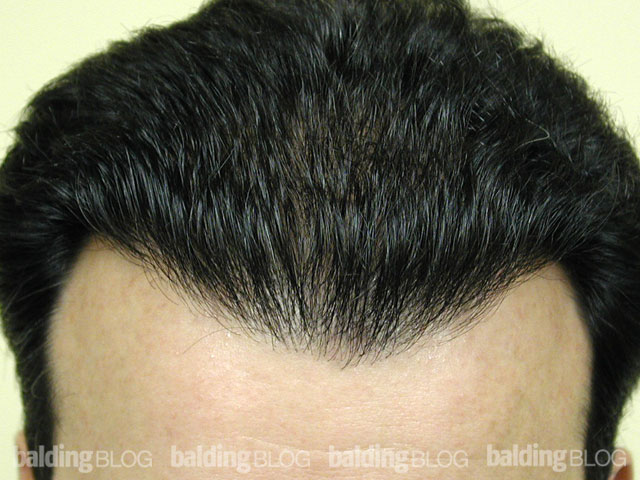
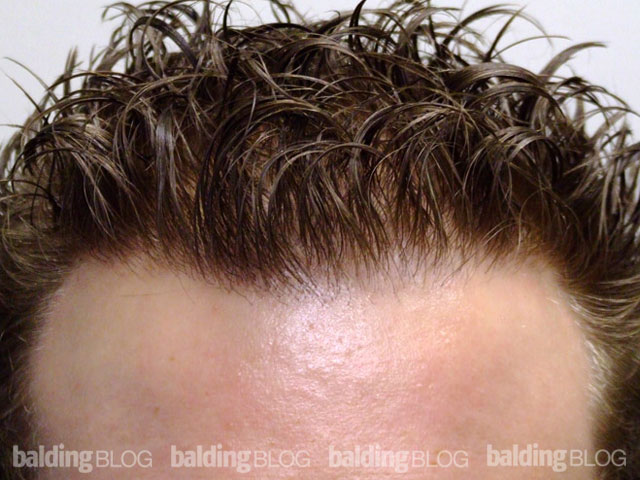
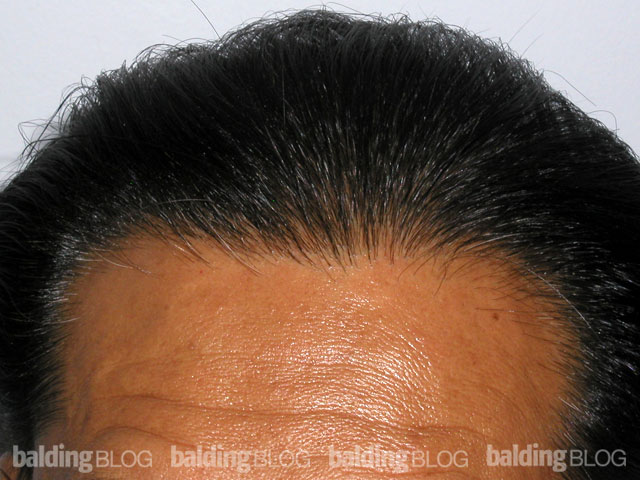
The entire hairlines of these three men are what is shown above. There is no original hair in these hairlines. Close-up views are a must for a side by side comparison to the Travolta photos above and for our readers to make their own judgments. We have men like these at our monthly open house events, because seeing is believing. I have many patients with sexy Travolta-style hairlines and each picture speaks for itself. Contrary to common belief, you can not tell a good hair transplant from a normal godly-produced head of hair in most circumstances.
Errors: https://baldingblog.com/wp-content/uploads/2019/03//photos/060317_travolta1.jpg is not accessible or supported filetype.https://baldingblog.com/wp-content/uploads/2019/03//photos/060317_travolta2.jpg is not accessible or supported filetype.https://baldingblog.com/wp-content/uploads/2019/03//photos/060317_patient1.jpg is not accessible or supported filetype.https://baldingblog.com/wp-content/uploads/2019/03//photos/060317_patient2.jpg is not accessible or supported filetype.https://baldingblog.com/wp-content/uploads/2019/03//photos/060317_patient3.jpg is not accessible or supported filetype.

 Some of the finer hair systems are created with a fine mesh material which then has hairs attached to the mesh, put together a hair at a time. At the hairline, a transparent plastic type material is used to match the skin tones and it is attached (glued) to the skin. For the mesh part behind the leading hairline edge, the hairs are layered so that the fine mesh does not show. The transition from front to back of the system must be meticulously put together.
Some of the finer hair systems are created with a fine mesh material which then has hairs attached to the mesh, put together a hair at a time. At the hairline, a transparent plastic type material is used to match the skin tones and it is attached (glued) to the skin. For the mesh part behind the leading hairline edge, the hairs are layered so that the fine mesh does not show. The transition from front to back of the system must be meticulously put together. 



